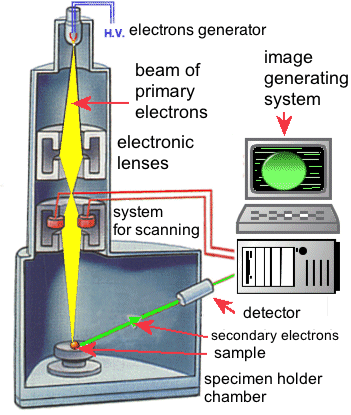

SEM: SCANNING ELECTRON MICROSCOPE
 The
Scanning
Electron
Microscope
- SEM
uses, as radiation source, a beam of
electrons with a wavelength shorter than
the visible light, that varies between 380 and 760 nanometers and too
big to be used in the observation of nano-samples. The beam of
electrons is produced by a metallic wire brought to high temperature,
therefore the emission of electrons is due to the thermionic effect.
When the atoms of the sample surface are struck by
the electron beam, they emit "secondary electrons" which
are detected and converted into electrical impulses. The electron
beam, highly focused, is moved along the surface of the sample, which
is analyzed portion per portion, so to obtain the "scan" of
the whole sample. SEM provides a complete three-dimensional image of
the sample and a very detailed image.
The
Scanning
Electron
Microscope
- SEM
uses, as radiation source, a beam of
electrons with a wavelength shorter than
the visible light, that varies between 380 and 760 nanometers and too
big to be used in the observation of nano-samples. The beam of
electrons is produced by a metallic wire brought to high temperature,
therefore the emission of electrons is due to the thermionic effect.
When the atoms of the sample surface are struck by
the electron beam, they emit "secondary electrons" which
are detected and converted into electrical impulses. The electron
beam, highly focused, is moved along the surface of the sample, which
is analyzed portion per portion, so to obtain the "scan" of
the whole sample. SEM provides a complete three-dimensional image of
the sample and a very detailed image.